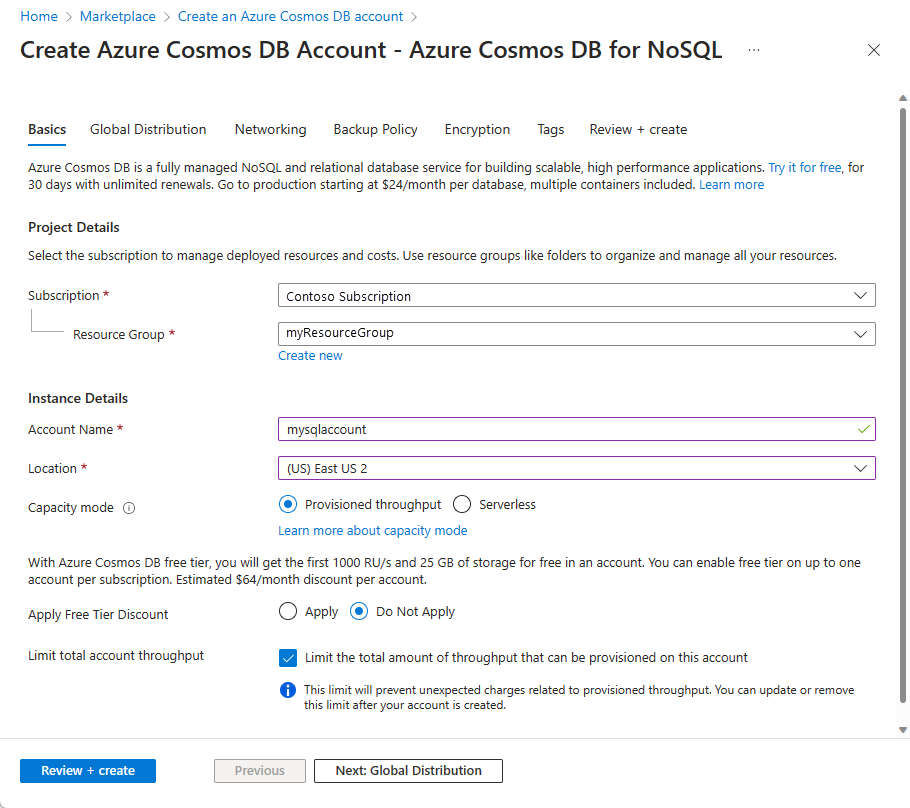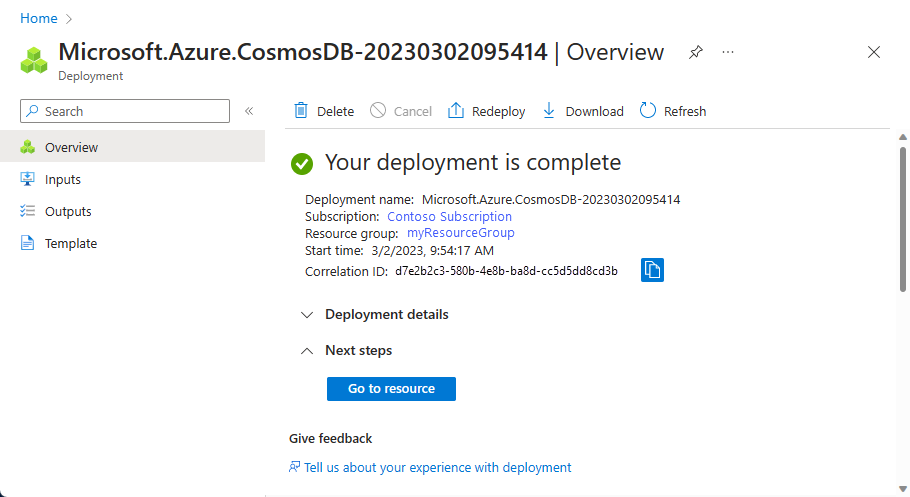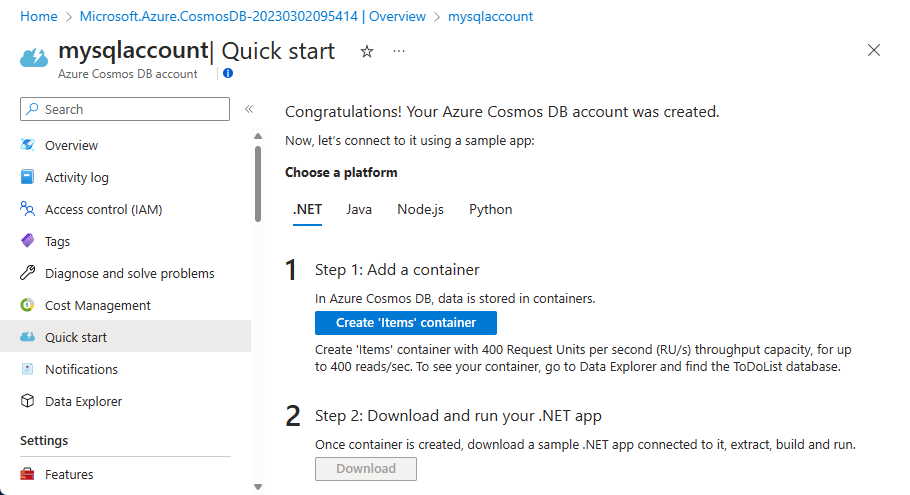Create a function triggered by Azure Cosmos DB
Learn how to create a function in the Azure portal that is triggered when data is added to or changed in Azure Cosmos DB. To learn more about Azure Cosmos DB, see Azure Cosmos DB: Serverless database computing using Azure Functions.
Note
In-portal editing is only supported for JavaScript, PowerShell, and C# Script functions. Python in-portal editing is supported only when running in the Consumption plan. When possible, you should develop your functions locally.
To learn more about the limitations on editing function code in the Azure portal, see Development limitations in the Azure portal.
Prerequisites
To complete this tutorial:
- If you don't have an Azure subscription, create a free account before you begin.
Note
Azure Cosmos DB bindings are only supported for use with Azure Cosmos DB for NoSQL. Support for Azure Cosmos DB for Table is provided by using the Table storage bindings, starting with extension 5.x. For all other Azure Cosmos DB APIs, you should access the database from your function by using the static client for your API, including Azure Cosmos DB for MongoDB, Azure Cosmos DB for Cassandra, and Azure Cosmos DB for Apache Gremlin.
Sign in to Azure
Sign in to the Azure portal with your Azure account.
Create an Azure Cosmos DB account
You must have an Azure Cosmos DB account that uses the SQL API before you create the trigger.
From the Azure portal menu or the Home page, select Create a resource.
Search for Azure Cosmos DB. Select Create > Azure Cosmos DB.
On the Create an Azure Cosmos DB account page, select the Create option within the Azure Cosmos DB for NoSQL section.
Azure Cosmos DB provides several APIs:
- NoSQL, for document data
- PostgreSQL
- MongoDB, for document data
- Apache Cassandra
- Table
- Apache Gremlin, for graph data
To learn more about the API for NoSQL, see Welcome to Azure Cosmos DB.
In the Create Azure Cosmos DB Account page, enter the basic settings for the new Azure Cosmos DB account.
Setting Value Description Subscription Subscription name Select the Azure subscription that you want to use for this Azure Cosmos DB account. Resource Group Resource group name Select a resource group, or select Create new, then enter a unique name for the new resource group. Account Name A unique name Enter a name to identify your Azure Cosmos DB account. Because documents.azure.com is appended to the name that you provide to create your URI, use a unique name. The name can contain only lowercase letters, numbers, and the hyphen (-) character. It must be 3-44 characters. Location The region closest to your users Select a geographic location to host your Azure Cosmos DB account. Use the location that is closest to your users to give them the fastest access to the data. Capacity mode Provisioned throughput or Serverless Select Provisioned throughput to create an account in provisioned throughput mode. Select Serverless to create an account in serverless mode. Apply Azure Cosmos DB free tier discount Apply or Do not apply With Azure Cosmos DB free tier, you get the first 1000 RU/s and 25 GB of storage for free in an account. Learn more about free tier. Limit total account throughput Selected or not Limit the total amount of throughput that can be provisioned on this account. This limit prevents unexpected charges related to provisioned throughput. You can update or remove this limit after your account is created. You can have up to one free tier Azure Cosmos DB account per Azure subscription and must opt in when creating the account. If you don't see the option to apply the free tier discount, another account in the subscription has already been enabled with free tier.
Note
The following options are not available if you select Serverless as the Capacity mode:
- Apply Free Tier Discount
- Limit total account throughput
In the Global Distribution tab, configure the following details. You can leave the default values for this quickstart:
Setting Value Description Geo-Redundancy Disable Enable or disable global distribution on your account by pairing your region with a pair region. You can add more regions to your account later. Multi-region Writes Disable Multi-region writes capability allows you to take advantage of the provisioned throughput for your databases and containers across the globe. Availability Zones Disable Availability Zones help you further improve availability and resiliency of your application. Note
The following options are not available if you select Serverless as the Capacity mode in the previous Basics page:
- Geo-redundancy
- Multi-region Writes
Optionally, you can configure more details in the following tabs:
- Networking. Configure access from a virtual network.
- Backup Policy. Configure either periodic or continuous backup policy.
- Encryption. Use either service-managed key or a customer-managed key.
- Tags. Tags are name/value pairs that enable you to categorize resources and view consolidated billing by applying the same tag to multiple resources and resource groups.
Select Review + create.
Review the account settings, and then select Create. It takes a few minutes to create the account. Wait for the portal page to display Your deployment is complete.
Select Go to resource to go to the Azure Cosmos DB account page.
Create a function app in Azure
From the Azure portal menu or the Home page, select Create a resource.
In the New page, select Compute > Function App.
On the Basics page, use the function app settings as specified in the following table:
Setting Suggested value Description Subscription Your subscription The subscription under which you create your new function app. Resource Group myResourceGroup Name for the new resource group in which you create your function app. You should create a new resource group because there are known limitations when creating new function apps in an existing resource group. Function App name Globally unique name Name that identifies your new function app. Valid characters are a-z(case insensitive),0-9, and-.Do you want to deploy code or container image? Code Option to publish code files or a Docker container. Runtime stack Preferred language Choose a runtime that supports your favorite function programming language. In-portal editing is only available for JavaScript, PowerShell, Python, TypeScript, and C# script. C# class library and Java functions must be developed locally. Version Version number Choose the version of your installed runtime. Region Preferred region Select a region that's near you or near other services that your functions can access. Operating system Windows An operating system is preselected for you based on your runtime stack selection, but you can change the setting if necessary. In-portal editing is only supported on Windows. Container publishing is only supported on Linux. Hosting options and plans Consumption (Serverless) Hosting plan that defines how resources are allocated to your function app. In the default Consumption plan, resources are added dynamically as required by your functions. In this serverless hosting, you pay only for the time your functions run. Premium plan also offers dynamic scaling. When you run in an App Service plan, you must manage the scaling of your function app. Accept the default options of creating a new storage account on the Storage tab and a new Application Insight instance on the Monitoring tab. You can also choose to use an existing storage account or Application Insights instance.
Select Review + create to review the app configuration you chose, and then select Create to provision and deploy the function app.
Select the Notifications icon in the upper-right corner of the portal and watch for the Deployment succeeded message.
Select Go to resource to view your new function app. You can also select Pin to dashboard. Pinning makes it easier to return to this function app resource from your dashboard.
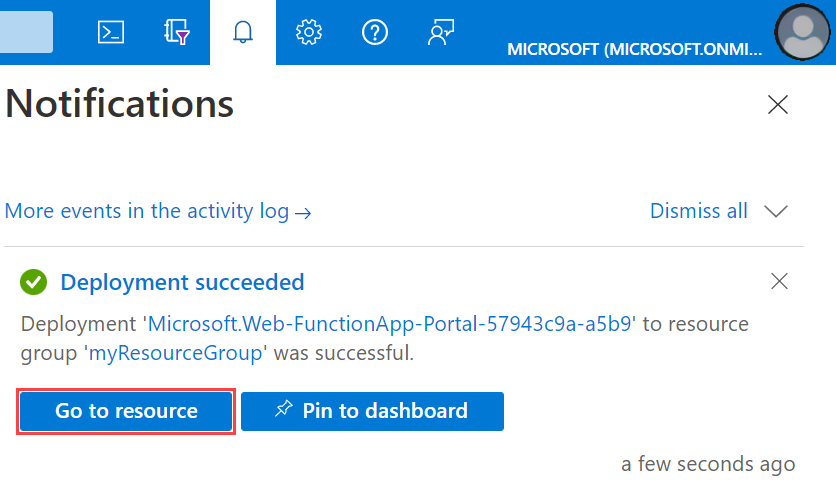
Next, you create a function in the new function app.
Create Azure Cosmos DB trigger
In your function app, select Overview, and then select + Create under Functions.
Under Select a template, scroll down and choose the Azure Cosmos DB trigger template.
In Template details, configure the new trigger with the settings as specified in this table, then select Create:
Setting Suggested value Description New function Accept the default name The name of the function. Azure Cosmos DB account connection Accept the default new name Select New, the Database Account you created earlier, and then OK. This action creates an application setting for your account connection. This setting is used by the binding to connection to the database. Database name Tasks Name of the database that includes the collection to be monitored. Collection name Items Name of the collection to be monitored. Collection name for leases leases Name of the collection to store the leases. Create lease collection if it does not exist Yes Checks for existence of the lease collection and automatically creates it. Azure creates the Azure Cosmos DB triggered function based on the provided values.
To display the template-based function code, select Code + Test.
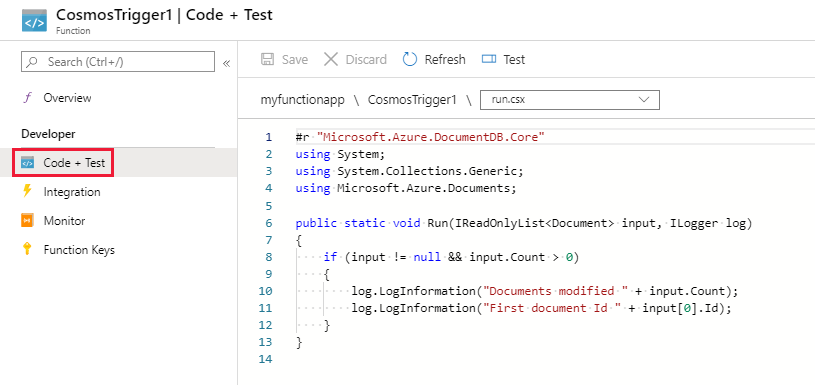
This function template writes the number of documents and the first document ID to the logs.
Next, you connect to your Azure Cosmos DB account and create the Items container in the Tasks database.
Create the Items container
Open a second instance of the Azure portal in a new tab in the browser.
On the left side of the portal, expand the icon bar, type
cosmosin the search field, and select Azure Cosmos DB.
Choose your Azure Cosmos DB account, then select the Data Explorer.
Under SQL API, choose Tasks database and select New Container.

In Add Container, use the settings shown in the table below the image.
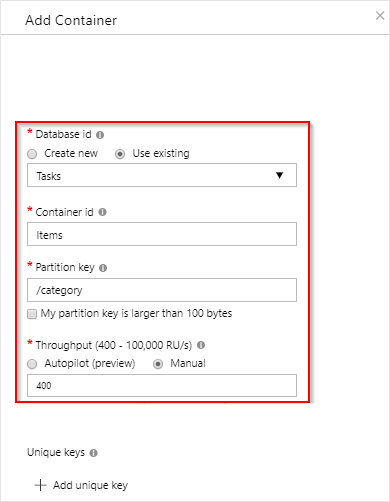
Setting Suggested value Description Database ID Tasks The name for your new database. This must match the name defined in your function binding. Container ID Items The name for the new container. This must match the name defined in your function binding. Partition key /category A partition key that distributes data evenly to each partition. Selecting the correct partition key is important in creating a performant container. Throughput 400 RU Use the default value. If you want to reduce latency, you can scale up the throughput later. Click OK to create the Items container. It may take a short time for the container to get created.
After the container specified in the function binding exists, you can test the function by adding items to this new container.
Test the function
Expand the new Items container in Data Explorer, choose Items, then select New Item.
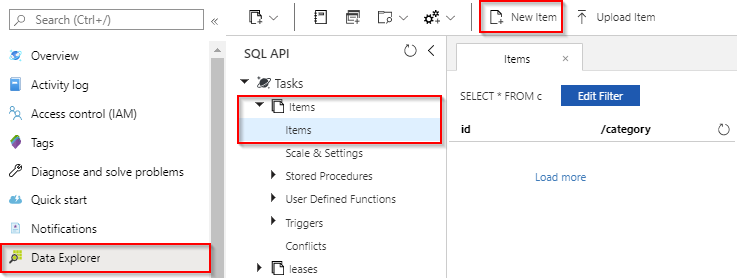
Replace the contents of the new item with the following content, then choose Save.
{ "id": "task1", "category": "general", "description": "some task" }Switch to the first browser tab that contains your function in the portal. Expand the function logs and verify that the new document has triggered the function. See that the
task1document ID value is written to the logs.
(Optional) Go back to your document, make a change, and click Update. Then, go back to the function logs and verify that the update has also triggered the function.
Clean up resources
Other quickstarts in this collection build upon this quickstart. If you plan to work with subsequent quickstarts, tutorials, or with any of the services you've created in this quickstart, don't clean up the resources.
Resources in Azure refer to function apps, functions, storage accounts, and so forth. They're grouped into resource groups, and you can delete everything in a group by deleting the group.
You've created resources to complete these quickstarts. You might be billed for these resources, depending on your account status and service pricing. If you don't need the resources anymore, here's how to delete them:
In the Azure portal, go to the Resource group page.
To get to that page from the function app page, select the Overview tab, and then select the link under Resource group.

To get to that page from the dashboard, select Resource groups, and then select the resource group that you used for this article.
In the Resource group page, review the list of included resources, and verify that they're the ones you want to delete.
Select Delete resource group and follow the instructions.
Deletion might take a couple of minutes. When it's done, a notification appears for a few seconds. You can also select the bell icon at the top of the page to view the notification.
Next steps
You have created a function that runs when a document is added or modified in your Azure Cosmos DB. For more information about Azure Cosmos DB triggers, see Azure Cosmos DB bindings for Azure Functions.
Now that you've created your first function, let's add an output binding to the function that writes a message to a Storage queue.
Feedback
Coming soon: Throughout 2024 we will be phasing out GitHub Issues as the feedback mechanism for content and replacing it with a new feedback system. For more information see: https://aka.ms/ContentUserFeedback.
Submit and view feedback for
